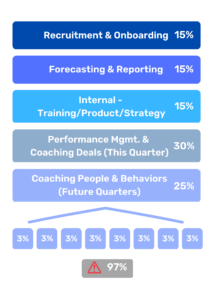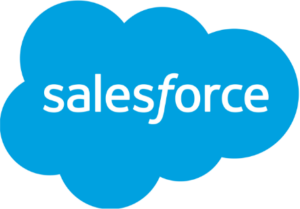Four Signs You’ve Got A Field Sales Coaching Problem
With four simple steps to fix it!
In complex B2B sales, front-line sales managers are one of the most important and highly leveraged roles in your business. Managers who are great coaches can get higher productivity from younger, less expensive salespeople, and can inspire the best on their team to go even higher. With 6, 8 or 10 reports, that’s a massive difference to sales productivity.
But most front-line managers behave more like “Super-Reps” than coaches. They are typically promoted into a management position because they were a great individual contributor, but this step-up is one of the hardest promotions in sales. For most, coaching skills are much harder to master than selling skills. As a result, most managers can coach deals, but not people. In other words, they can coach opportunities, but not behaviors, and as a result they fail to unlock the potential of the salespeople “in the middle”.
“Most front-line managers can coach deals, but not people”
Deal coaching is relatively easy. If a manager has been selling successfully, you can bet they’re pretty good at providing advice to a rep on moving a deal through the pipeline. But advice by itself doesn’t deliver the “A-ha” moments that really change behavior, and advice doesn’t scale.
If a Regional Sales Manager with 8 reports invests a full 25% of their time to coaching people (which is unusually high), they will still only have around 3% of their month 1:1 with each rep. What happens in that 3% makes a massive difference to what happens in the other 97%.
Unpopular opinion – with financial reporting cycles getting faster, we’re spending too much time looking at pipeline, and not enough looking at our people.
Don’t get me wrong – I’m a big fan of good pipeline analytics. A host of good products (Salesforce Tableau, Microsoft Power BI, Cognos and many others) deliver wonderful information to sales leaders and RevOps / sales operations teams.

But few leaders have a dashboard showing them their “people analytics”. Few leaders can run a report that answers fundamental questions like these:
- What are the strengths and competency gaps of each salesperson on my team?
- Which of my front-line managers can coach, and which ones can’t?

If you don’t already have this type of “people” dashboard, here are a few easy signs that will help you determine if you have a coaching problem, and therefore an opportunity to drive sales productivity.
Four clear signs that you’ve got a coaching problem:
-
If 80% of your revenue comes from 20% of your people…
You’ve got a coaching problem. Of course, we always expect a bell-curve of performance in a team, but an 80:20 mix indicates that the top performing group are sixteen times more productive than the other 80%. (4x the output from 1/4 of the people). That’s a massive productivity gap, which often means that your managers can’t bring the “middle” up a level that is at least closer to the top performers.
-
If the same salespeople make President’s Club every year…
You’ve got a coaching problem. If the same reps are always on the top of the leaderboard, it’s another sign that you’ve got managers who don’t know how to “grow the middle”. It is also a red flag for risk – relying on a few superstars is great while it lasts but losing a few top people can really tank your business.
-
If your regular salesperson churn is higher than 15%…
You’ve got a coaching problem. I’m not talking about simple, high velocity, “playbook” style sales such as inside sales/SDRs where you move fairly junior salespeople through roles very quickly. But in complex and field sales teams, high churn often points to competency gaps with your front-line managers. Remember – great people leave bad bosses. If you can reduce churn by training your managers to coach the middle-performers and motivate the top achievers, you’ll retain the top and get a lot more out of the rest – and reduce recruitment costs on the way.
-
If your front-line managers can’t tell you what the specific competencies and gaps of each person on their team are…
They’re not coaching people; they’re just pushing deals. It indicates that they don’t really understand half of their role.

“Underperforming managers are very, very expensive”
Four simple ways to fix it:
-
Create a simple, practical competency framework for reps and managers
It continues to amaze me how many B2B sales organizations don’t know “what good looks like”. Don’t delegate this framework to your HR team alone – it’s a core responsibility for your sales, sales operations and commercial execution leaders. Don’t overcomplicate it – for reps, competencies should focus on territory and account management (are they chasing the biggest prizes in their territory), call planning for critical client meetings, and the client-facing skills to execute these big meetings that really move the needle. For managers, focus on their ability to credibly assess these competencies in their reps, and coach the gaps.
-
Align manager incentives to focus on revenue AND people
Build (or buy) a simple dashboard that shows you call planning, coaching and competencies across your entire field team. This drives accountability and discipline across even the largest field sales teams – “They won’t respect what you don’t inspect”. Review your front-line manager KPIs and augment their revenue targets with coaching goals. Align incentives and remuneration to these goals. Obviously, managers still need to deliver the numbers but adding these KPIs gets them thinking beyond this quarter. If you want some more information on designing the right sort of KPIs and competencies for your team, contact us.
-
Focus your training investments on front-line managers
Because managers typically have 6 to 10 reports, it’s usually the highest training ROI you can get. A typical B2B field sales manager is managing a team with a payroll of $800,000 to $3M per year. In enterprise sales, the team’s revenue goal might be tens or even hundreds of millions of dollars. Underperforming managers are very, very expensive. Good manager training focuses on competency assessment, how to get the most from field travel, how to segment your team, and how to coach and inspire.
-
Don’t do coaching “off-line” – make it part of your managers’ daily workflow
This is the most commonly overlooked step in building a great learning organization. Most coaching software and tools run as a separate app, disconnected from your CRM and the everyday manager workflow. As a result, coaching becomes an occasional, administrative task rather than an important part of the manager’s day to day.

Building scalable sales muscle
Pipeline analytics are not going away – they provide essential tools and data for modern sales leaders. But the best teams will continue to augment their “RevOps” with “PeopleOps” to drive ongoing productivity improvement from their biggest investment – their people.
Warren Buffet once said that “Only when the tide goes out do you discover who’s been swimming naked”. It’s never too late to get back to the basics. With a good, simple PeopleOps plan, you can start to see who on your team is swimming naked, and fix it before.
Good selling!

SWIFT™ for
Supercharge your CRM with a coaching and performance accelerator.
Interested in a fully integrated Salesforce app that delivers value-added call planning, transforms your managers from super-reps into coaches, and gives leaders a real-time dashboard of team competencies?
Swagger Sales™ trains your team to perform better and gives you the tools to track progress.
The dashboards bring all the information into one place – it’s really about accountability, you can look at it very quickly to see if you have a problem in a certain area.
Kim Moller, Senior Vice President of Sales
MiMedx Group, Inc


